(349 products available)
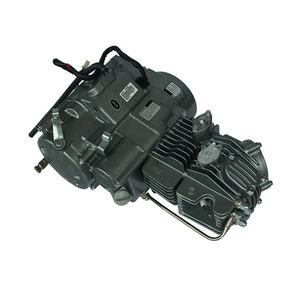





















































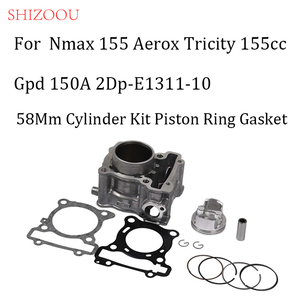
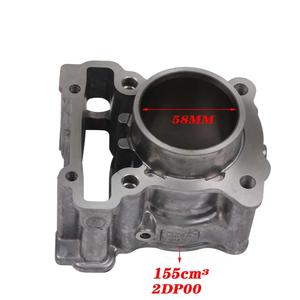

























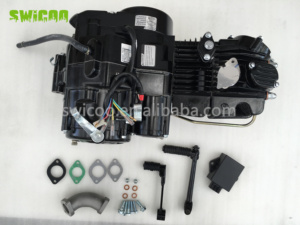











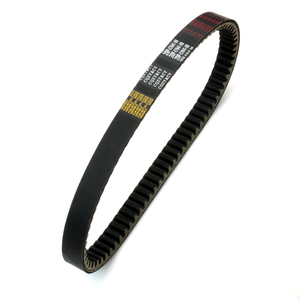


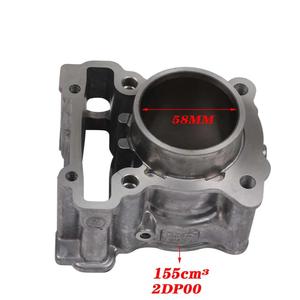

























































































A 155cc engine displaces 155 cubic centimeters or 0.155 liters. It's common in scooters and small motorcycles, offering a balance between efficiency and adequate power. Here are the types of 155cc engines:
Air-cooled engines:
Air-cooled 155cc engines use ambient air to regulate temperature. They have fins on the engine block that enhance airflow during operation. These engines are simpler and lighter, making them ideal for scooters and small motorcycles. They also require less maintenance because they lack cooling systems like water or oil.
Liquid-cooled engines:
Liquid-cooled 155cc engines use coolant circulation for temperature control. The coolant circulates through channels in the engine and the radiator, dissipating heat. These engines are more consistent in temperature regulation, allowing for higher performance. They are more complex and heavier than air-cooled engines. Liquid cooling is beneficial when the engine works hard or in hot environments.
Single-cylinder engines:
Single-cylinder 155cc engines have one piston cylinder. They are simple, lightweight, and have a low parts count, which makes them affordable and easy to maintain. However, they produce uneven power strokes and vibrations because of the single cylinder.
Parallel twin-cylinder engines:
Parallel twin-cylinder 155cc engines have two side-aligned cylinders. They offer smoother power delivery and less vibration than single-cylinder engines. The even power strokes from the two cylinders balance the engine, improving stability and performance.
SOHC (Single Overhead Camshaft) engines:
SOHC 155cc engines have one camshaft controlling the intake and exhaust valves in the cylinder head. This design is simpler and cost-effective, enhancing reliability and performance in the mid-range power band. The camshaft requires less maintenance than DOHC engines.
DOHC (Dual Overhead Camshaft) engines:
DOHC 155cc engines have two camshafts for each cylinder bank. This layout allows for precise valve control, higher revs, and better performance at high speeds. They are more complex and require more maintenance than SOHC engines.
The following are specifications for the 155cc engines:
Engine type:
This is the arrangement of the engine. For the 155cc engines, they have an engine with a solitary chamber, 4-stroke air-cooled motor.
Displacement:
The displacement of the 155cc engines is 155 cubic centimeters. This is equivalent to 0.155 liters or 9.45 cubic inches.
Bore and Stroke:
The bore is the measurement of the chamber's width in which the cylinder moves up and down. For the 155cc engine, the chamber bore is 58 mm (2.28 inches). The stroke is the distance that the piston moves up and down in the chamber. The stroke for the 155cc engine is 59 mm (2.32 inches).
Compression Ratio:
The 155cc engine has a pressure proportion of 10.5:1 to 11.5:1. This proportion shows the degree of pressure of the fuel-air combination in the chamber before ignition.
Power Output:
The power output of the 155cc engines is 8.6 kW (11.5 hp) to 13 kW (17.4 hp). This power output is for when the engine is running at 8,000 revolutions per minute (RPM).
Torque:
The torque for the 155cc engine is 12 N·m (8.9 lb·ft) to 14 N·m (10.4 lb·ft). This torque is for when the engine is running at 6,500 RPM.
Fuel System:
The fuel system for the 155cc engines consists of a carburetor or fuel infusion framework that blends fuel with air and conveys it to the motor chambers for ignition.
Ignition System:
The 155cc engine has an electric start system. The start framework produces a flash to ignite the fuel-air blend in the motor chamber.
Cooling System:
The 155cc engine has a cooling framework that cools the motor to keep it from overheating. The cooling framework for the 155cc engine is air-based or water-based.
Lubrication System:
The lubrication system for the 155cc engine lubricates the moving parts of the engine to reduce wear and tear. The lubrication system works by using engine oil.
Below are the following maintenance practices for the 155cc engine:
Oil Change:
Regular oil changes are important for keeping the 155cc engine running smoothly. The old oil is drained and replaced with new oil. This helps to remove any dirt or debris that may have built up in the oil. Oil changes should be done after every 50 hours of use or every 6 months, whichever comes first.
Air Filter Replacement:
The air filter is responsible for keeping dirt and debris out of the engine. Over time, the air filter can become clogged, which can affect the engine's performance. Replacing the air filter is an easy task that can be done by removing the cover and replacing the old filter with a new one. This should be done every 100 hours of use or every year.
Spark Plug Replacement:
The spark plug is responsible for igniting the fuel in the engine. Over time, the spark plug can become worn, which can affect the engine's performance. Replacing the spark plug is a simple task that can be done by removing the old spark plug and replacing it with a new one. This should be done every 200 hours of use or every two years.
Valve Clearance Adjustment:
The valves control the flow of air and fuel in and out of the engine. Over time, the valve clearance can become out of spec, which can affect the engine's performance. Adjusting the valve clearance requires a bit more technical knowledge, but it can be done by using a feeler gauge and adjusting the clearance as per the manufacturer's specifications. This should be done every 300 hours of use or every three years.
Fuel System Maintenance:
The fuel system is responsible for delivering fuel to the engine. Over time, the fuel system can become clogged, which can affect the engine's performance. Cleaning the fuel system is an easy task that can be done by using a fuel system cleaner and adding it to the fuel tank as per the manufacturer's instructions. This should be done every 400 hours of use or every four years.
Cooling System Maintenance:
The cooling system keeps the engine at the right temperature. Over time, the coolant level can become low, which can affect the engine's temperature. Checking the coolant level and topping up as needed is an easy task. This should be done every 500 hours of use or every five years.
Choosing a 155 cc engine requires considering several factors. What is the purpose of the bike? Knowing the purpose of the bike will help decide the engine capacity required. For instance, for long-distance travel, a 155 cc engine is ideal since it offers good fuel efficiency and can maintain a higher speed with less strain.
Another factor to consider when choosing a 155 cc engine is the riding style. Different engines suit different riding styles. If the bike is meant for everyday city commuting, a 155 cc engine is ideal because it offers quick acceleration and allows the rider to maneuver through traffic easily. For off-road riding, a 155 cc engine with good torque delivery is suitable.
Also consider the fuel type required by the bike's engine. Most 155 cc engines run on gasoline. However, some require premium gasoline with a higher octane rating. Ensure the fuel is readily available before choosing a 155 cc engine.
Replacing a 155cc engine on a vehicle is a complex task that requires mechanical knowledge and experience. It is advisable to consult a professional mechanic for assistance. However, if one has the necessary skills and knowledge, here are some steps to guide in replacing a 155cc engine:
Before starting the replacement process, gather all the necessary tools that will be needed. This includes:
With the tools ready, follow the steps below:
Disconnect the battery:
Disconnect the battery to avoid any electrical accidents.
Drain fluids:
Drain all fluids from the old engine, including oil and coolant, and put them in a clean container for proper disposal.
Remove the old engine:
Follow the instructions in the service manual to disconnect and remove the old engine from the vehicle.
Prepare the new engine:
Install the engine onto the engine stand and follow the instructions in the service manual to prepare the new engine.
Install the new engine:
Follow the instructions in the service manual to install the new engine onto the vehicle.
Reconnect all systems:
Reconnect all systems disconnected during the engine replacement. This includes electrical connections, fuel lines, and cooling hoses.
Refill fluids:
Refill the new engine with oil and coolant.
Reconnect the battery:
Reconnect the battery after the engine replacement is complete and the vehicle is reassembled.
Q1: How much power does a 155cc engine have?
A1: A 155cc is considered to have a decent power output. The power output of a 155cc engine can vary depending on factors like engine design, configuration, and manufacturer specifications. In general, a 155cc engine produces between 10 and 15 horsepower (7.5 to 11 kW) and 10 to 12 lb-ft (14 to 16 Nm) of torque. This is enough power for small vehicles like scooters, lawnmowers, and light-duty tasks.
Q2: How fast can a 155cc engine go?
A2: The 155cc engine's top speed depends on the vehicle's design, the engine's tuning, and other factors. Generally, a 155cc engine can reach speeds of 60 to 70 mph (96 to 113 km/h). However, factors like aerodynamics, weight, and tire size can affect the engine's speed.
Q3: What is the 155cc 4-stroke engine?
A3: The 155cc 4-stroke engine is a common engine configuration in many vehicles, especially in small and medium-sized motorbikes and scooters. During the first intake stroke, the air-fuel mixture enters the combustion chamber. The second compression stroke compresses the air-fuel mixture. During the third power stroke, the air-fuel mixture is ignited by a spark, causing combustion that pushes the piston down. During the fourth exhaust stroke, the exhaust gases are expelled from the combustion chamber, and the cycle repeats.